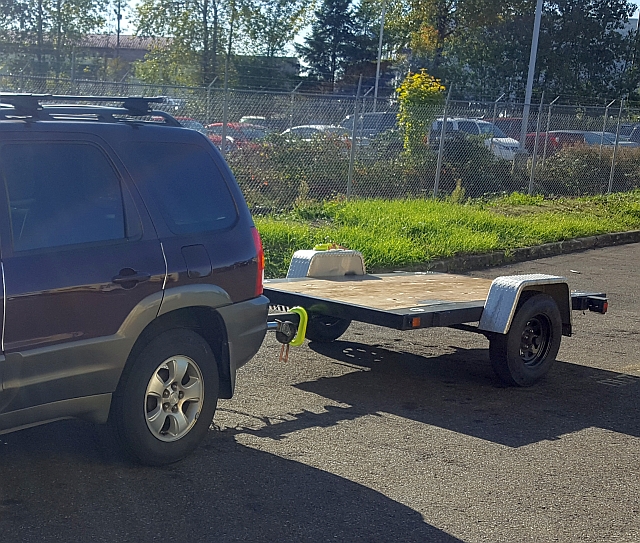
This page shows and tells how one old guy (me) moves a heavy piece of steel plate home and maneuvers it safely onto a table. It touches on how I set up my table for track burning, and how I do track burning safely indoors.
The subject of this page is a piece of 1/4" steel plate that measures 4x8 feet. Given that a square foot of 1/4" steel weighs just about 10 pounds, it's simple to calculate that the plate weighs 320 pounds. Now, that isn't a whole lot of weight. But I'm in my Medicare years now and that's too big and heavy a piece for one guy like me to move safely without help.
Of course, the way I do things isn't the only way to do them. I used to do things differently. This is just what things have evolved to around here.
The story starts at the steelyard, in this case Farwest Steel in Renton, Washington. That's about 20 miles from my house, so the first problem is how to transport a full sheet of steel with my little SUV. I don't own a pickup truck or flatbed truck because it's just too expensive to insure for the amount I would use it. Plus, my neighbors would hate some ratty old truck parked in my neighborhood. So I keep a little trailer around for jobs like these. Here's my little trailer parked in the steelyard:

I don't have to do any heavy lifting at the steelyard. They drop it neatly into place on my trailer with a forklift:
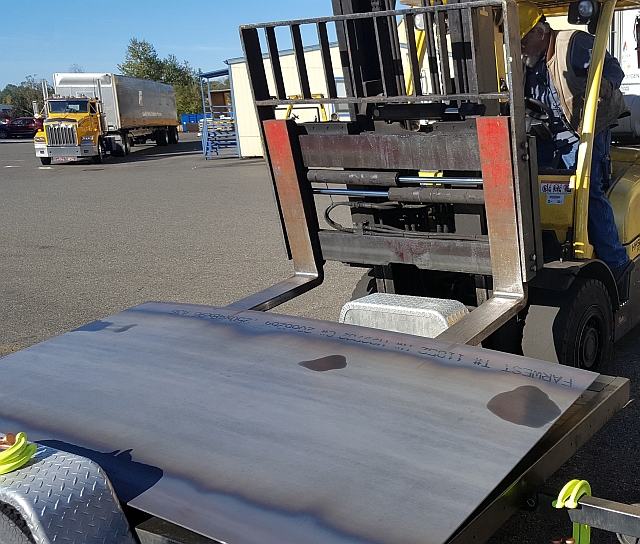
Let me digress for a minute. My trailer is nominally a 5x8' flatbed. They used to sell these at Costco. It isn't much, but it's plenty for this job. Of course, the plate has to be securely fastened to the trailer so it doesn't blow off on the 20 miles of freeway home. Here's the easy way to do that using C-clamps:

I'm sure there are better ways to tie down plate to a flatbed, but I've been hauling steel home clamped to my vehicles for quite a few years now. These are beefy name brand C-clamps and I'm confident in them.
At any rate, the plate got home just fine. The trailer rode straight and sweet. Now, if you think about it, it probably would be possible to slide the plate straight off the back of the trailer by myself. But then I'd have a 320 pound piece lying flat on the ground. And I can't pick up one side of that by myself anymore, that's for sure! So here's how I do it. First, I back the trailer under a shop-made gantry crane:

It can be quite tricky to pick up a big piece of plate with a single overhead hook. A plate clamp, though, makes the job easy. Here's mine ready for the lift. Note the tape measure in the background - it sure works better if the plate clamp is in the middle!
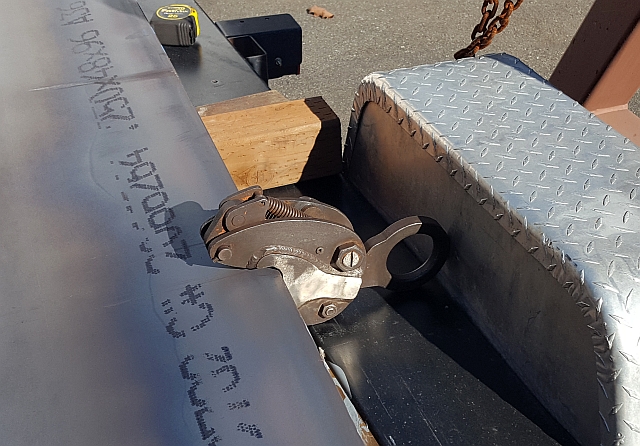
I'm sure you can see the next step coming - pick the plate up and drive the trailer out from under, of course! Here's the plate just hanging in the air:

Ignore the pallet of steel under the plate in the picture above. It has nothing to do with this story, but it may show up in some future one.
This plate is going inside of my shop and onto my welding table, where I plan to cut it up with a track burner. The welding table is only about thirty feet away, but how to deal with moving that awkward piece? With another shop-made cart, of course. I built a plate dolly that lets me easily move a piece of plate standing up on its side. The next image shows the plate set down onto the plate dolly.
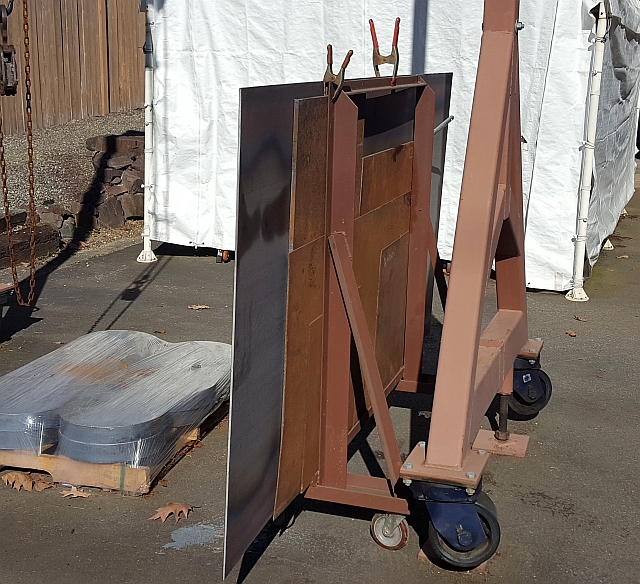
That plate dolly works so well with pieces of plate steel that I just store a bunch of it on there. I probably have a few hundred pounds of steel not even counting today's piece. No matter, it still rolls easily. The spring clamps keep the plate stock from falling over.
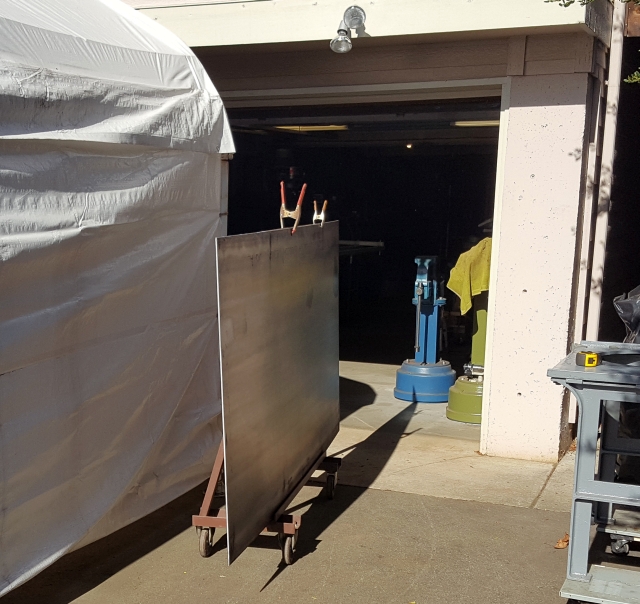
So now the plate is in the shop. Still haven't broken a sweat. I have to pick the plate up and lay it down on my table. And I'm going to need help to do that. You have already met my plate clamp. Here is my shop crane with the plate clamp on it. I'm sure you can see how I can attach the standing-up plate to the shop crane and lift it:

The next picture shows the crane in place next to the plate dolly, rigged to the plate, which is now free to lift. Have a look:
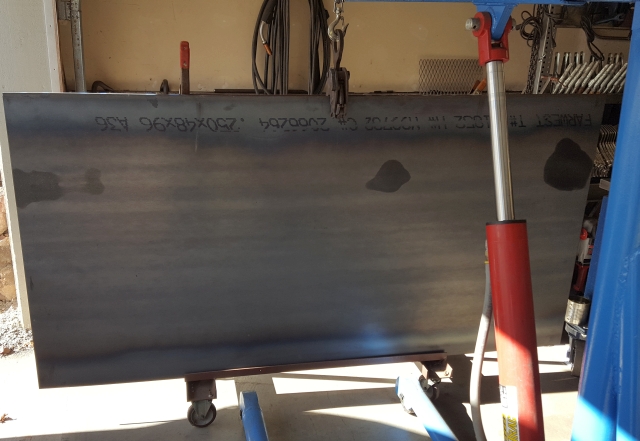
The next bit wasn't easy to photograph, so I'm going to attempt to talk you through it. I rolled the plate (picked up by the shop crane) to the far side of my welding table, and set it down so its edge sat on some little pieces of 3/4" pipe. Then I released the plate clamp and rolled the plate sideways until it was fully next to my table. Then I moved the shop crane so its legs went under the table and again clamped the plate in the middle and lifted it most of the way up to the tabletop height. Then I pulled on the crane while gently lowering the boom. I did have to give it a stout pull, but it was easy to lay it down gently onto the table:

With the weight of the plate supported by the table, it was easy to pull it around 90 degrees. At this point, the only moving left to do was to slide it around on the table as it was being cut up. But how to set up the track burner? I have to say I've been using a torch most of my life and I do not like how a piece just falls on the floor as the operation to cut it off ends. So I built a burning cradle which supports the part to be cut off, just at tabletop height. See:

To set up my ancient track burner, I put a couple of pieces of square tube sideways across the pieces of superstrut that are part of my burning cradle. And a length of track on top of those, with the track burner (of course) riding on the track. Then, a little fiddling and it's time to start cutting the plate up! Of course, the plate gets smaller and lighter as each part is cut off by the oxypropane flame. By the time the plate will come off the table, it will be small enough for me to easily lift it by myself. So that's how an old guy moves around a big piece of plate!
I'll leave you with an image of the first cut:
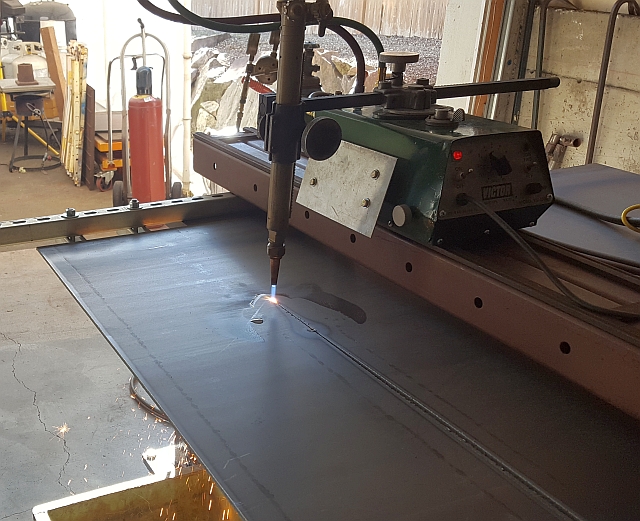
Thanks for reading!